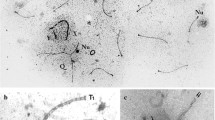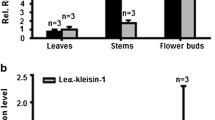Abstract
Complete reconstruction of seven leptotene, six zygotene, three pachytene and three diplotene nuclei has permitted to follow the pairing process in the Ascomycete Sordaria macrospora. The seven bivalents in Sordaria can be identified by their length. The lateral components of the synaptonemal complexes (SC) are formed just after karyogamy but are discontinuous at early leptotene. Their ends are evenly distributed on the nuclear envelope. The homologous chromosomes alignment occurs at late leptotene before SC formation. The precise pairing starts when a distance of 200–300 nm is reached. Each bivalent has several independent central component initiation sites with preferentially pairing starting near the nuclear envelope. These sites are located in a constant position along the different bivalents in the 6 observed nuclei. The seven bivalents are not synchronous either in the process of alignment or in SC formation: the small chromosomes are paired first. At pachytene the SC is completed in each of the 7 bivalents. Six bivalents have one “fixed” and one randomly attached telomeres. The “fixed” end of the nucleolar organizer is the nucleolus anchored end. At diffuse stage and diplotene, only small stretches of the SC are preserved. The lateral components increase in length is approximately 34% between leptotene and pachytene. Their lengths remain constant during pachytene. From zygotene to diplotene the central components contain local thickenings (nodules). At late zygotene and pachytene each bivalent has 1 to 4 nodules and the location of at least one is constant. The total number of nodules remains constant from pachytene to diplotene and is equal to the mean total number of chiasmata. The observations provide additional insight into meiotic processes such as chromosome movements, initiation and development of the pairing sites during zygotene, the existence of “fixed” telomeres, the variations in SC length. The correspondence between nodules and chiasmata are discussed.
Similar content being viewed by others
References
Barry, E.G.: The diffuse diplotene stage of meiotic prophase in Neurospora. Chromosoma (Berl.) 26, 119–129 (1969)
Buss, M.E., Henderson, S.A.: Induced bivalent interlocking and the course of meiotic chromosome synapsis. Nature (Lond.) 234, 243–246 (1971)
Byers, B., Goetsch, L.: Electron microscopic observations on the meiotic karyotype of diploid and tetraploid Saccharomyces cerevisiae. Proc. nat. Acad, Sci. (Wash.) 72, 5056–5060 (1975)
Carpenter, A.T.C.: Electron microscopy of meiosis in Drosophila melanogaster females. I: Structure, arrangement and temporal change of the synaptonemal complex in wild-type. Chromosoma (Berl.) 51, 157–182 (1975)
Carpenter, A.T.C.: Electron microscopy of meiosis in Drosophila melanogaster females. II: The recombination nodule — a recombination-associated structure at pachytene? Proc. nat. Acad. Sci. (Wash.) 72, 3186–3189 (1975)
Chauhan, K.P.S., Abel, W.O.: Evidence for the association of homologous chromosomes during premeiotic stages in Impatiens and Salvia. Chromosoma (Berl.) 25, 297–302 (1968)
Esposito, R.E., Esposito, M.S.: Genetic recombination and commitment to meiosis in Saccharomyces. Proc. nat. Acad. Sci. (Wash.) 71, 3172–3176 (1974)
Esser, K., Kuenen, R.: Genetik der Pilze. Ergänzter Neudruck. Berlin-Heidelberg-New York: Springer 1967
Galey, F.R., Nilsson, S.E.G.: A new method for transferring sections from the liquid surface of the trough through staining solution to the supporting film of a grid. J.Ultrastruct. Res. 14, 405–410 (1966)
Gillies, C.B.: Reconstruction of the Neurospora crassa pachytene Karyotype from serial sections of synaptonemal complexes. Chromosoma (Berl.) 36, 119–130 (1972)
Gillies, C.B.: Ultrastructural analysis of maize pachytene Karyotypes by three dimensional reconstruction of the synaptonemal complexes. Chromosoma (Berl.) 43, 145–176 (1973)
Gillies, C.B.: An ultrastructural analysis of chromosomal pairing in maize. C. R. Trav. Lab. Carlsberg 40, 135–161 (1975)
Gillies, C.B.: Synaptonemal complex and chromosome structure. Ann. Rev. Genet. 9, 91–109 (1975)
Jones, G.H.: Modified synaptinemal complexes in spermatocytes of Stethophyma grossum. Cold Spr. Harb. Symp. quant. Biol. 38, 109–115 (1973)
Lu, B.C.: The course of meiosis and centriole behavior during the ascus development of the Ascomycete Gelasinospora calospora. Chromosoma (Berl.) 22, 210–226 (1967)
Maguire, M.P.: Evidence for homologous pairing of chromosomes prior to meiotic prophase in maize. Chromosoma (Berl.) 21, 221–231 (1967)
Maguire, M.P.: Role of heterochromatin in homologous chromosome pairing: evaluation of evidence. Science 176, 543–544 (1972)
Moens, P.B.: The structure and function of the synaptinemal complex in Lilium longiflorum sporocytes. Chromosoma (Berl.) 23, 418–451 (1968)
Moens, P.B.: The fine structure of meiotic chromosome polarization and pairing in Locusta migratoria spermatocytes. Chromosoma (Berl.) 28, 1–25 (1969)
Moens, P.B.: Quantitative electron microscopy of chromosome organization at meiotic prophase. Cold Spr. Harb. Symp. quant. Biol. 38, 99–107 (1973)
Moses, M.J.: Synaptinemal complex. Ann. Rev. Genet. 2, 363–412 (1968)
Radu, M., Steinlauf, R., Koltin, Y.: Meiosis in Schizophyllum commune chromosomal behavior and the synaptinemal complex. Arch. Microbiol. 98, 301–310 (1974)
Rasmussen, S.W.: Studies on the development and ultrastructure of the synaptinemal complex in Drosophila melanogaster. C. R. Trav. Lab. Carlsberg 39, 443–468 (1974)
Rasmussen, S.W.: The meiotic prophase in Bombyx mori females analyzed by three dimensional reconstructions of synaptonemal complexes. Chromosoma (Berl.) 54, 245–293 (1976)
Rizet, G., Engelmann, C.: Contribution à l'étude génétique d'un Ascomycète tétrasporé: Podospora anserina (Ces.) Rev. Cytol. Biol. Vég. 11, 201–304 (1949)
Rossen, J.M., Westergaard, M.: Studies on the mechanism of crossing-over II: Meiosis and time of meiotic chromosome replication in the ascomycete Neottiella rutilans. C. R. Trav. Lab. Carlsberg 35, 233–260 (1966)
Roth, T.F., Ito, M.: DNA dependent formation of the synaptinemal complex at meiotic prophase. J.Cell Biol. 35, 247–255 (1967)
Schrantz, J.P.: Etude cytologique, en microscopie optique et électronique, de quelques Ascomycètes. I: Le noyau. Rev. Cytol. Biol. Vég. 33, 1–100 (1970)
Sotelo, J.R., Garcia, R.B., Wettstein, R.: Serial sectioning study of some meiotic stages in Scaptericus borrelli (Grylloidea). Chromosoma (Berl.) 42, 307–333 (1973)
Stern, H., Hotta, J.: Biochemical controls of meiosis. Ann. Rev. Genet. 7, 37–66 (1973)
Wagenaar, E.B.: End-to-end chromosome attachments in mitotic interphase and their possible significance to meiotic chromosome pairing. Chromosoma (Berl.) 26, 410–426 (1969)
Welsch, B.: Synaptonemal Complex und Chromosomenstruktur in der achiasmatischen Spermatogenese von Panorpa communis (Mecoptera). Chromosoma (Berl.) 43, 19–74 (1973)
Westergaard, M., Wettstein, D. von: Studies on the mechanism of crossing-over. IV: The molecular organization of the synaptinemal complex in Neottiella (Cooke) Saccardo (Ascomycetes). C. R. Trav. Lab. Carlsberg 37, 239–268 (1970)
Westergaard, M., Wettstein, D. von: The synaptinemal complex. Ann. Rev. Genet. 6, 71–110 (1972)
Zickler, D.: Fine structure of chromosome pairing in ten ascomycetes: Meiotic and premeiotic (mitotic) synaptonemal complexes. Chromosoma (Berl.) 40, 401–416 (1973)
Zickler, D.: La méiose et les mitoses au cours du cycle de quelques Ascomycètes. Thèse d'état, Université de Paris-Sud, centre d'Orsay (1973)
Author information
Authors and Affiliations
Rights and permissions
About this article
Cite this article
Zickler, D. Development of the synaptonemal complex and the “recombination nodules” during meiotic prophase in the seven bivalents of the fungus Sordaria macrospora Auersw. Chromosoma 61, 289–316 (1977). https://doi.org/10.1007/BF00288615
Received:
Accepted:
Issue Date:
DOI: https://doi.org/10.1007/BF00288615




